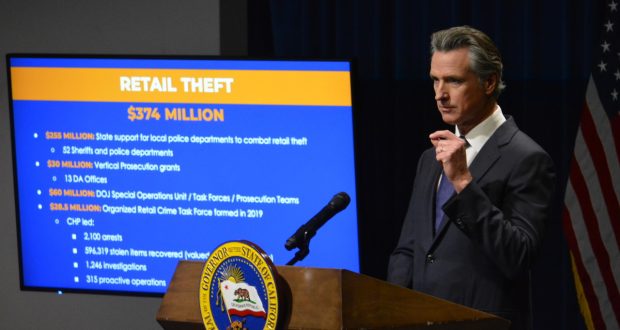Gov. Gavin Newsom presented a $291 billion spending plan to the California Legislature on Jan. 10. Despite a looming shortfall estimated at tens of billions of dollars, Newsom avoided making cuts to critical expenditures in education, public safety, curbing organized retail theft, housing for the homeless, mental health care reform, climate action, and other issues that are priorities.
During his speech, delivered at the auditorium of the Secretary of State building in Sacramento, Newsom clarified that he expects the state to have a $37.9 billion deficit. That figure is considerably lower than the nearly $68 billion deficit projected last month by the nonpartisan Legislative Analyst Office (LAO).
“Those of you who’ve been writing about a different number I hope you’re immediately correcting,” Newsom said moments into his presentation. “We’ve been pretty damn transparent with you by making the point publicly, not just privately that that was not the number, but it continues to be reported as the gospel.”
On Jan. 13, the LAO released an analysis of Newsom’s budget proposal that placed the amount of the budget deficit problem to about $58 billion, $10 billion lower than its original projection and nearly $20 million more than the Department of Finance calculations.
In addition to ordering a reduction on general fund spending last month, Newsom proposed a number of actions to bridge the budget gap during his presentation, including the possibility of declaring a budget emergency, which would allow him to borrow cash from the state’s reserves. He also suggested making “moderate cuts” totaling $8.5 billion in spending from some programs that support climate change initiatives, housing and other services; and reconsidering the healthcare wage increase.
“Our state is in a strong position to close this shortfall while protecting key priorities and programs that millions of Californians rely on,” Newsom remained upbeat about the state’s economic forecast. “I look forward to partnering with the Legislature to meet this moment with a balanced approach that meets the needs of Californians and safeguards our state’s future.”
During the Q&A session after his presentation, Newsom, in response to a question posed by California Black Media stated that he took deliberate steps to safeguard programs that the California Legislative Black Caucus (CLBC) had identified as important. They included the state’s equity multiplier funding program designed to support schools with significant numbers of socioeconomically disadvantaged children – an initiative strongly advocated by Assemblymember Akilah Weber (D-La Mesa), and funding for the Ralph J.Bunche Center for African American Studies at UCLA.
In a statement released Jan. 11, State Controller Malia M. Cohen, who is responsible for accountability and disbursement of the state’s resources, says that she has faith in Newsom’s projections.
“While the Governor had difficult choices to make to address the budget shortfall, I’m confident that the budget announced (Jan. 10) will keep California moving forward and continue the work necessary to support vital public health and safety programs along with other core services,” Cohen stated. “As Controller, my office is prepared to provide the tools and resources necessary to ensure the state meets its financial obligations and maintains economic stability.”
Newsom’s budget plan reflects $18.4 billion in total budgetary reserves, including $11.1 billion in the Rainy Day Fund.
Secretary of State Shirley N. Weber thanked Newsom’s for keeping funding flat for programs that are central to the services her department delivers, including two new digital programs that promote transparency in political financing and provides electronic notarization of business documents.
“The January Budget includes resources for the Secretary of State to maintain its core ongoing operations,” said Weber.
“In addition, the Budget includes funding to support the Help America Vote Act mandates and resources to continue the CAL-ACCESS Replacement System (CARS) Project and to support the continuation of the Notary Automation Program Replacement Project (NAP 2.0) which are mission critical and vital to the services the SOS provides to the public, Legislature, and its stakeholders,” Weber added.
Several Republican lawmakers expressed their disapproval of Newsom’s spending plan, including Assembly Minority Leader James Gallagher (R-Yuba City), who called the Governor’s budget “pure fantasyland.”
Senate Minority Leader Brian W. Jones (R-San Diego) and Vice Chair of the Senate Budget and Fiscal Review Committee, Sen. Roger Niello (R-Fair Oaks) also shared their views on Newsom’s budget proposal.
Jones stated in a Jan. 10 statement that Newsom’s plan is “year six of ‘Gavinomics’ where his budgets turn surpluses into deficits and his policies push Californians to flee.”
Niello stated that the governor’s rhetoric is a way to weave “through a deficit of dollars.”
“As the governor pulls revenue gimmicks and accounting tricks, it’s impossible to bury the truth: California is bleeding because of a decade of Democrats’ one-party rule and reckless spending,” Niello stated.
Calling California’s economy, the “greatest wealth generator in the world,” Newsom said he is confident California will close its budget gap, continue on its overall path of prosperity while providing innovative solutions to address social and economic issues.
“This is a story of correction, a story of normalization after a period of a tremendous amount of distortion,” Newsom said.
 Westside Story Newspaper – Online The News of The Empire – Sharing the Quest for Excellence
Westside Story Newspaper – Online The News of The Empire – Sharing the Quest for Excellence





